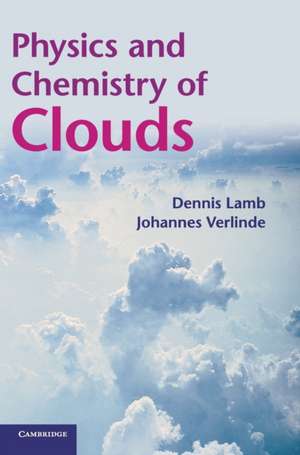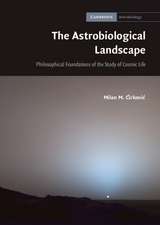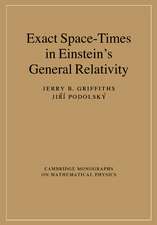Physics and Chemistry of Clouds
Autor Dennis Lamb, Johannes Verlindeen Limba Engleză Hardback – 27 apr 2011
Preț: 715.94 lei
Preț vechi: 832.49 lei
-14% Nou
Puncte Express: 1074
Preț estimativ în valută:
136.99€ • 143.03$ • 113.38£
136.99€ • 143.03$ • 113.38£
Carte tipărită la comandă
Livrare economică 04-18 aprilie
Preluare comenzi: 021 569.72.76
Specificații
ISBN-13: 9780521899109
ISBN-10: 0521899109
Pagini: 600
Ilustrații: 287 b/w illus. 2 tables 80 exercises
Dimensiuni: 181 x 254 x 31 mm
Greutate: 1.32 kg
Editura: Cambridge University Press
Colecția Cambridge University Press
Locul publicării:Cambridge, United Kingdom
ISBN-10: 0521899109
Pagini: 600
Ilustrații: 287 b/w illus. 2 tables 80 exercises
Dimensiuni: 181 x 254 x 31 mm
Greutate: 1.32 kg
Editura: Cambridge University Press
Colecția Cambridge University Press
Locul publicării:Cambridge, United Kingdom
Cuprins
1. Introduction; 2. The atmospheric setting; 3. Equilibria; 4. Change; 5. Cloud thermodynamics; 6. Cloud formation and evolution; 7. Nucleation; 8. Growth from the vapor; 9. Growth by collection; 10. Evolution of supersaturation; 11. Warm clouds; 12. Cold clouds; 13. Cloud chemistry; 14. Electrification; Appendix A. Cloud classification; Appendix B. Basics of thermodynamics; Appendix C. Boltzmann distribution; Index.
Recenzii
'The Lamb and Verlinde book joins the ranks of the classic treatises on clouds. It is ideally suited for a graduate course in cloud physics and chemistry.' John H. Seinfeld, Louis E. Nohl Professor, California Institute of Technology (Caltech)
'At long last an up-to-date textbook is now available on the physics and chemistry of clouds suitable for use by upper division undergraduate students and first-year graduate students. It has now been almost 20 years since the last book on cloud microphysics was published. But this book is so much more than a cloud microphysics book as it encompasses atmospheric chemistry and the basics for all of physical meteorology including atmospheric radiation. The book is truly designed as a textbook rather than a source book as it includes problem sets at the end of each chapter. I think that lecturers and students alike will appreciate this valuable new book.' William R. Cotton, Colorado State University
'This book fills a void that exists between elementary books and those designed as references for researchers. It is the first time that a textbook [has been] published which is designed for graduate level courses and for students that are seasoned or new to the field of cloud physics and chemistry. [It] describes the microphysical and mesoscale processes in clouds and their interactions in a clear and comprehensive way … designed as a textbook, each chapter is concluded with a list of references for further reading and a set of problems … the reader is led through the difficult topics of cloud development in a logical way which [whets] the appetite to investigate in more depth the outstanding issues of this fascinating field. I expect the book to be the main textbook for many years to come.' Zev Levin, Goldemberg Chair Professor in Atmospheric Physics, Tel Aviv University
'It is great that there is a new book at the level of Pruppacher and Klett (1997), that discusses cloud microphysical processes in depth and captures the progress that has been made in the scientific community since then. I'll be happy to use it as a textbook in my graduate class on cloud microphysics.' Ulrike Lohmann, Institute for Atmospheric and Climate Science, ETH Zurich
'… very valuable … suited for readers such as advanced students in atmospheric science … a very useful and popular textbook in atmospheric physics classes …' Barbara Ervens, Bulletin of the American Meteorological Society
'At long last an up-to-date textbook is now available on the physics and chemistry of clouds suitable for use by upper division undergraduate students and first-year graduate students. It has now been almost 20 years since the last book on cloud microphysics was published. But this book is so much more than a cloud microphysics book as it encompasses atmospheric chemistry and the basics for all of physical meteorology including atmospheric radiation. The book is truly designed as a textbook rather than a source book as it includes problem sets at the end of each chapter. I think that lecturers and students alike will appreciate this valuable new book.' William R. Cotton, Colorado State University
'This book fills a void that exists between elementary books and those designed as references for researchers. It is the first time that a textbook [has been] published which is designed for graduate level courses and for students that are seasoned or new to the field of cloud physics and chemistry. [It] describes the microphysical and mesoscale processes in clouds and their interactions in a clear and comprehensive way … designed as a textbook, each chapter is concluded with a list of references for further reading and a set of problems … the reader is led through the difficult topics of cloud development in a logical way which [whets] the appetite to investigate in more depth the outstanding issues of this fascinating field. I expect the book to be the main textbook for many years to come.' Zev Levin, Goldemberg Chair Professor in Atmospheric Physics, Tel Aviv University
'It is great that there is a new book at the level of Pruppacher and Klett (1997), that discusses cloud microphysical processes in depth and captures the progress that has been made in the scientific community since then. I'll be happy to use it as a textbook in my graduate class on cloud microphysics.' Ulrike Lohmann, Institute for Atmospheric and Climate Science, ETH Zurich
'… very valuable … suited for readers such as advanced students in atmospheric science … a very useful and popular textbook in atmospheric physics classes …' Barbara Ervens, Bulletin of the American Meteorological Society
Notă biografică
Descriere
A quantitative yet approachable clouds textbook for advanced students, researchers and professionals in atmospheric science, meteorology, environmental sciences/engineering, atmospheric chemistry.










